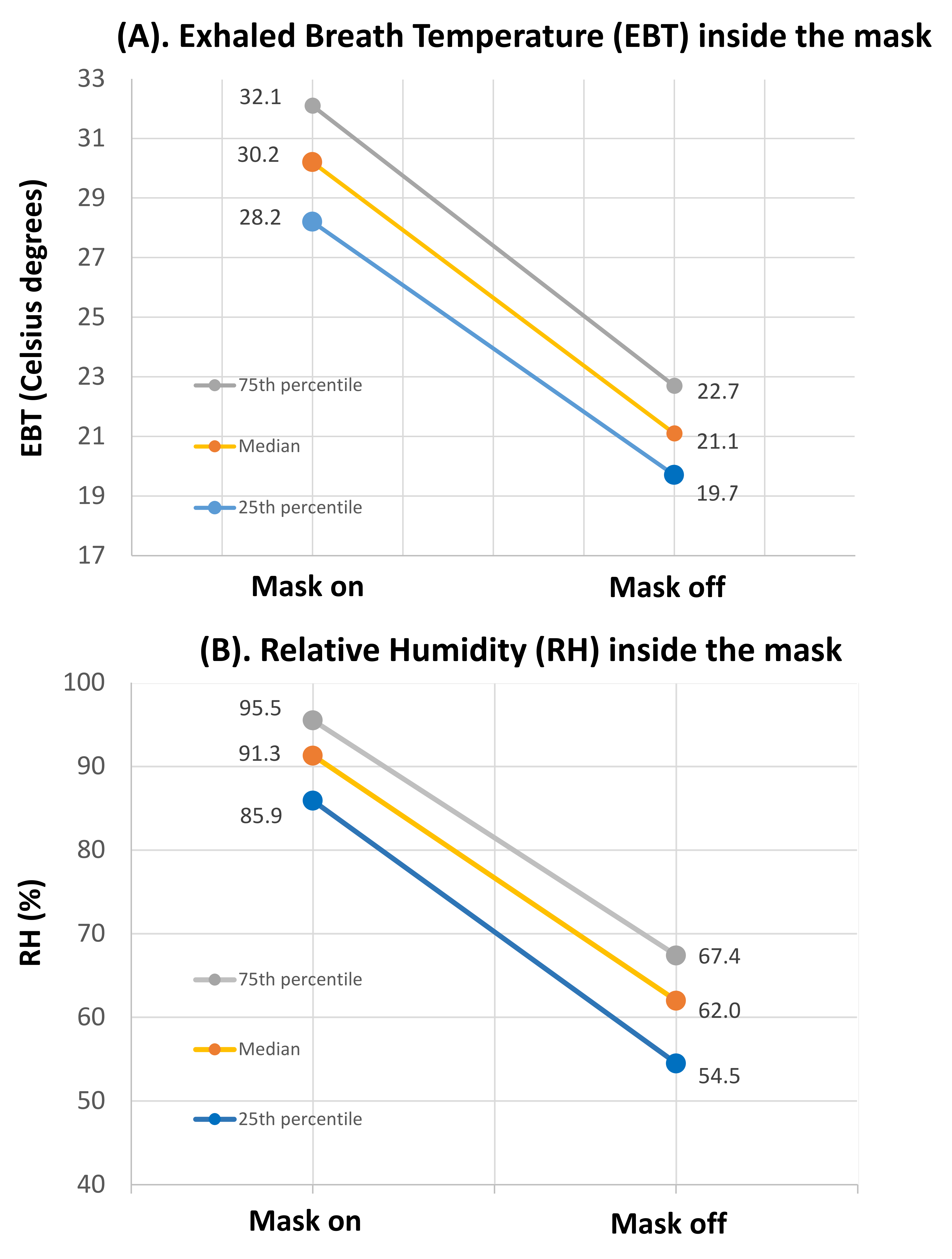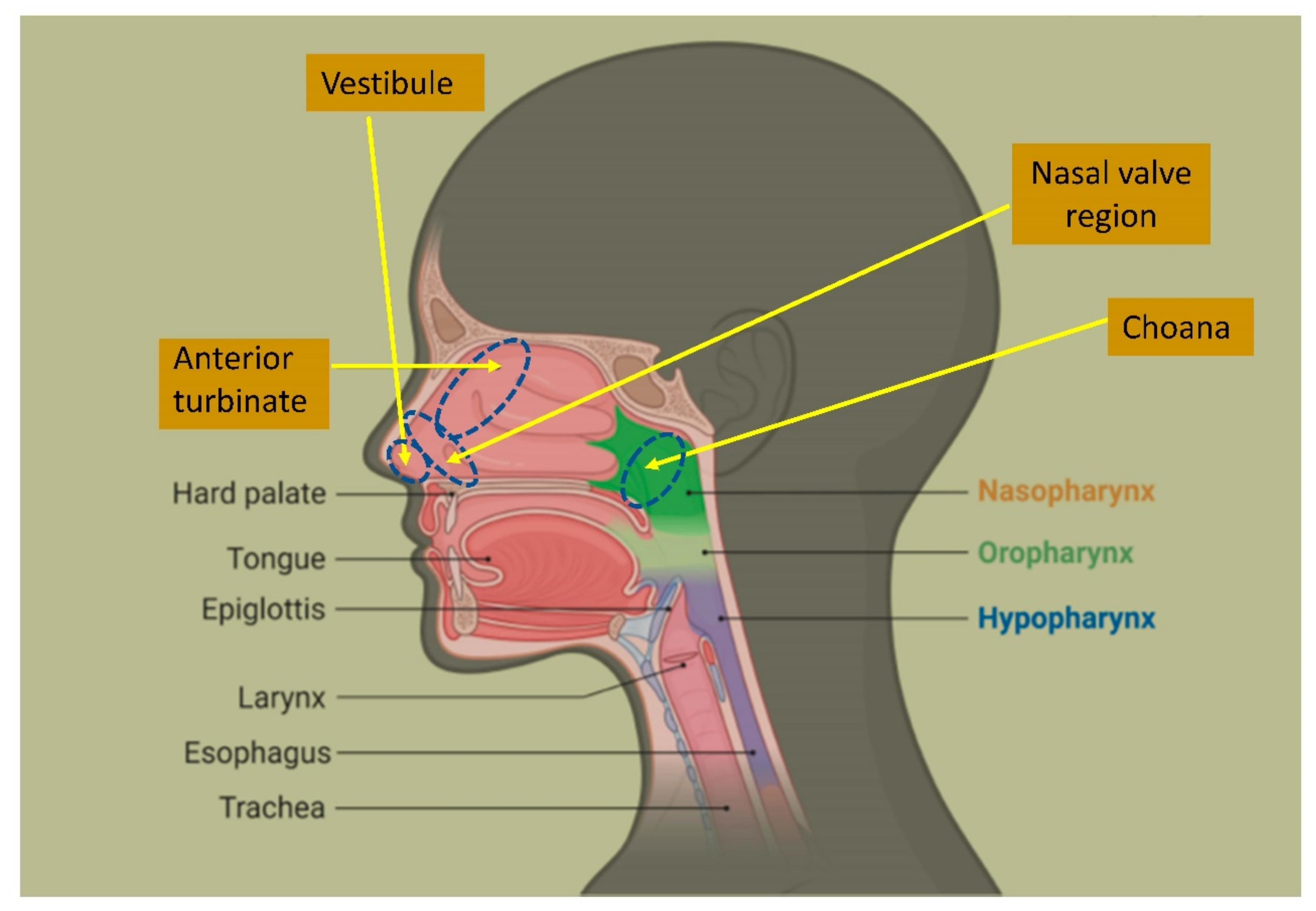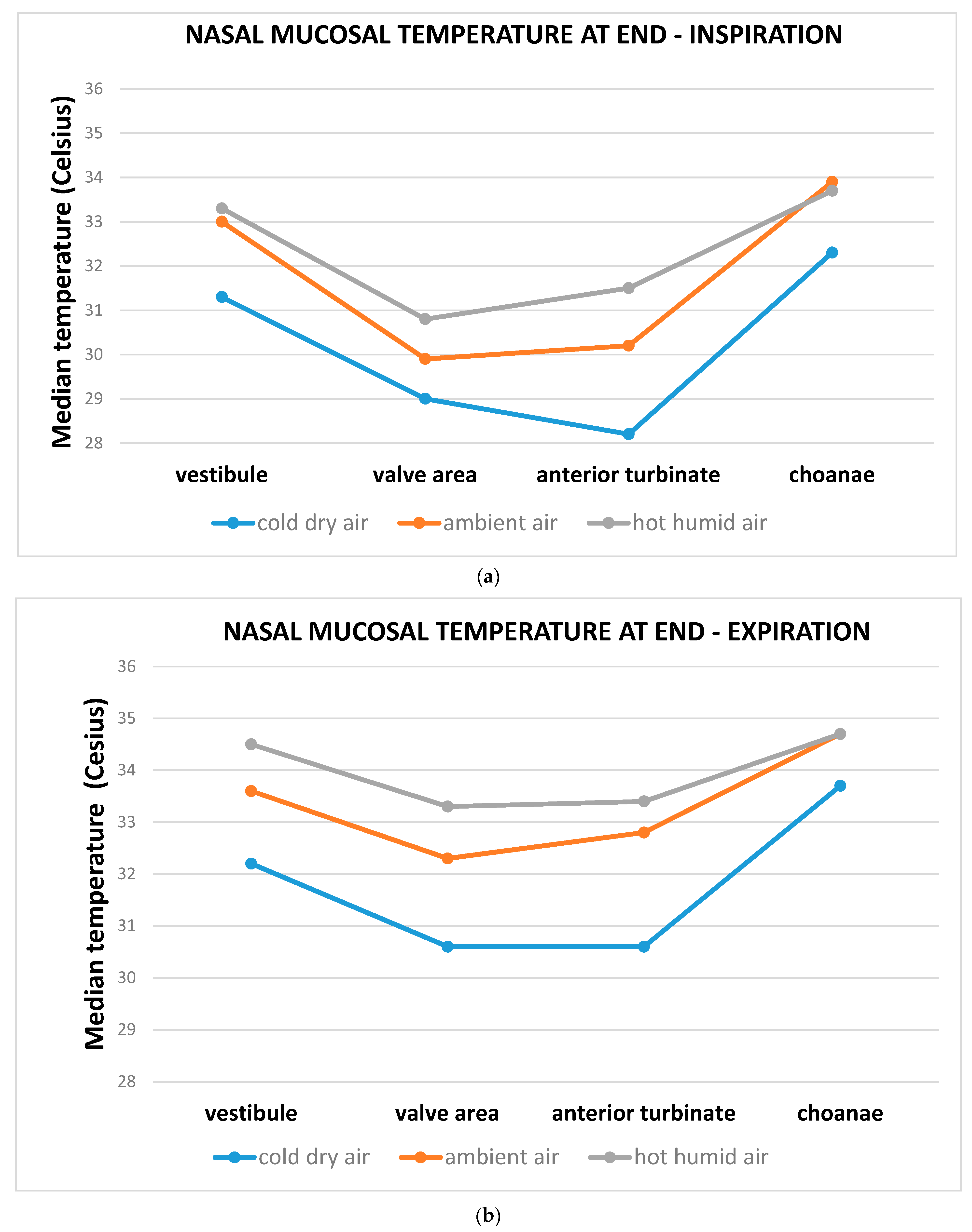Community Use of Face Masks against the Spread of COVID-19
Abstract
1. Background
2. Results and Discussion
2.1. Ambient Temperature and Nasal Microclimate
2.2. The Impact of Cold Temperature on the Innate Human Defense System of Upper Airways
Cold Temperature and Respiratory Viruses
2.3. SARS-CoV-2, Allergy and Face Masks
2.3.1. SARS-CoV-2, Air Pollution, Blood Pressure and Face Masks
Filtering Efficacy of Face Masks
2.3.2. Adverse Effects and Acceptability of Face Masks
3. Conclusions
Author Contributions
Funding
Institutional Review Board Statement
Informed Consent Statement
Data Availability Statement
Conflicts of Interest
References
- Guo, L.; Ren, L.; Yang, S.; Xiao, M.; Chang, D.; Yang, F.; Cruz, C.S.D.; Wang, Y.; Wu, C.; Xiao, Y.; et al. Profiling Early Humoral Response to Diagnose Novel Coronavirus Disease (COVID-19). Clin. Infect. Dis. 2020, 71, 778–785. [Google Scholar] [CrossRef]
- Lu, R.; Zhao, X.; Li, J. Genomic characterization and epidemiology of 2019 novel coronavirus: Implications for virus origins and receptor binding. Lancet 2020, 395, 565–574. [Google Scholar] [CrossRef]
- Zhou, P.; Yang, X.-L.; Wang, X.-G.; Hu, B.; Zhang, L.; Zhang, W.; Si, H.-R.; Zhu, Y.; Li, B.; Huang, C.-L.; et al. A pneumonia outbreak associated with a new coronavirus of probable bat origin. Nature 2020, 579, 270–273. [Google Scholar] [CrossRef]
- Walls, A.; Park, Y.J.; Tororici, M.A.; Wall, A.; McGuire, A.T.; Veesler, D. Structure, function, and antigenicity of the SARS-Cov-2 spike glycoprotein. Cell 2020, 181, 281–292.e6. [Google Scholar] [CrossRef] [PubMed]
- Ou, X.; Liu, Y.; Lei, X.; Li, P.; Mi, D.; Ren, L.; Guo, L.; Guo, R.; Chen, T.; Hu, J.; et al. Characterization of spike glycoprotein of SARS-CoV-2 on virus entry and its immune cross-reactivity with SARS-CoV. Nat. Commun. 2020, 11, 1620. [Google Scholar] [CrossRef] [PubMed]
- Patel, A.B.; Verma, A. Nasal ACE2 Levels and COVID-19 in Children. JAMA 2020, 323, 2386. [Google Scholar] [CrossRef]
- Cegolon, L. Investigating hypothiocyanite against SARS-CoV-2. Int. J. Hyg. Environ. Health 2020, 227, 113520. [Google Scholar] [CrossRef] [PubMed]
- Cegolon, L.; Javanbakht, M.; Mastrangelo, G. Nasal disinfection for the prevention and control of COVID-19: A scoping review on potential chemo-preventive agents. Int. J. Hyg. Environ. Health 2020, 230, 113605. [Google Scholar] [CrossRef]
- Cegolon, L.; Pichierri, J.; Mastrangelo, G.; Cinquetti, S.; Sotgiu, G.; Bellizzi, S.; Pichierri, G. Hypothesis to explain the severe form of COVID-19 in Northern Italy. BMJ Glob. Health 2020, 5, e002564. [Google Scholar] [CrossRef] [PubMed]
- Cegolon, L.; Mirandola, M.; Salaris, C.; Salvati, M.V.; Mastrangelo, G.; Salata, C. Hypothiocyanite and Hypothiocyanite/Lactoferrin Mixture Exhibit Virucidal Activity In Vitro against SARS-CoV-2. Pathogens 2021, 10, 233. [Google Scholar] [CrossRef]
- Chua, M.H.; Cheng, W.; Goh, S.S.; Kong, J.; Li, B.; Lim, J.Y.C.; Mao, L.; Wang, S.; Xue, K.; Yang, L.; et al. Face Masks in the New COVID-19 Normal: Materials, Testing, and Perspectives. Research 2020, 2020, 1–40. [Google Scholar] [CrossRef] [PubMed]
- Center for Disease Control and Prevention (CDC). Scientific Brief: Community Use of Cloth Masks to Control the Spread of SARS-CoV-2. Available online: https://www.cdc.gov/coronavirus/2019-ncov/more/masking-science-sars-cov2.html (accessed on 29 January 2020).
- Carbon, C.-C. The Psychology of Wearing Face Masks in Times of the COVID-19 Pandemic. SSRN Electron. J. 2020. [Google Scholar] [CrossRef]
- Betsch, C.; Korn, L.; Sprengholz, P.; Felgendreff, L.; Eitze, S.; Schmid, P.; Böhm, R. Social and behavioral consequences of mask policies during the COVID-19 pandemic. Proc. Natl. Acad. Sci. USA 2020, 117, 21851–21853. [Google Scholar] [CrossRef] [PubMed]
- Widdicombe, J.G. Comparison between the vascular beds of upper and lower airways. Eur. Respir. J. Suppl. 1990, 12, 564s–571s. [Google Scholar]
- Lundqvist, G.R.; Pedersen, O.F.; Hilberg, O.; Nielsen, B. Nasal reaction to changes in whole body temperature. Acta Oto-Laryngol. 1993, 113, 783–788. [Google Scholar] [CrossRef]
- Le Merre, C.; Isber, J.; Chediak, A.D.; Wanner, A. Effects of cold dry air nasal stimulation on airway mucosal blood flow in humans. Arch. Physiol. Biochem. 2003, 111, 327–329. [Google Scholar] [CrossRef]
- Olsson, P.; Bende, M.; Ohlin, P. The Laser Doppler Flowmeter for Measuring Microcirculation in Human Nasal Mucosa. Acta Oto-Laryngol. 1985, 99, 133–139. [Google Scholar] [CrossRef] [PubMed]
- Liener, K.; Leiacker, R.; Lindemann, J.; Rettinger, G.; Keck, T. Nasal Mucosal Temperature after Exposure to Cold, Dry Air and Hot, Humid Air. Acta Oto-Laryngol. 2003, 123, 851–856. [Google Scholar] [CrossRef]
- Gupta, D. “Therapeutic” facemasks. Med. Hypotheses 2020, 143, 109855. [Google Scholar] [CrossRef] [PubMed]
- Gupta, D. Living with in-mask micro-climate. Med. Hypotheses 2020, 144, 110010. [Google Scholar] [CrossRef]
- Yip, W.; Leung, L.; Lau, P.; Tong, H. The Effect of Wearing a Face Mask on Body Temperature. Hong Kong J. Emerg. Med. 2005, 12, 23–27. [Google Scholar] [CrossRef]
- Roberge, R.J.; Kim, J.H.; Coca, A. Protective face mask impact on human thermoregulation: An overview. Ann. Occup. Hyg. 2012, 56, 102–112. [Google Scholar]
- Cherrie, J.W.; Wang, S.; Mueller, W.; Wendelboe-Nelson, C.; Loh, M. In-mask temperature and humidity can validate respirator wear-time and indicate lung health status. J. Expo. Sci. Environ. Epidemiol. 2018, 29, 578–583. [Google Scholar] [CrossRef]
- Keck, T.; Lindemann, J. Numerical simulation and nasal air-conditioning. GMS Curr. Top. Otorhinolaryngol. Head Neck Surg. 2010, 9. [Google Scholar] [CrossRef]
- Popov, T.A.; Dunev, S.; Kralimarkova, T.Z.; Kraeva, S.; DuBuske, L.M. Evaluation of a simple, potentially individual device for exhaled breath temperature measurement. Respir. Med. 2007, 101, 2044–2050. [Google Scholar] [CrossRef]
- Melo, R.E.; Popov, T.A.; Solé, D. Exhaled breath temperature, a new biomarker in asthma control: A pilot study. J. Bras Pneumol. 2010, 36, 693–699. [Google Scholar] [CrossRef]
- Popov, T.; Petrova, D.; Kralimarkova, T.; Ivanov, Y.; Popova, T.; Peneva, M.; Odzhakova, T.; Ilieva, Y.; Yakovliev, P.; Lazarova, T.; et al. Real life clinical study design supporting the effectiveness of extra-fine inhaled beclomethasone/formoterol at the level of small airways of asthmatics. Pulm. Pharmacol. Ther. 2013, 26, 624–629. [Google Scholar] [CrossRef]
- Cherrie, J.W.; Apsley, A.; Cowie, H.; Steinle, S.; Mueller, W.; Lin, C.; Horwell, C.J.; Sleeuwenhoek, A.; Loh, M. Effectiveness of face masks used to protect Beijing residents against particulate air pollution. Occup. Environ. Med. 2018, 75, 446–452. [Google Scholar] [CrossRef]
- Bustamante-Marin, X.M.; Ostrowski, L.E. Cilia and Mucociliary Clearance. Cold Spring Harb. Perspect. Biol. 2017, 9, a028241. [Google Scholar] [CrossRef]
- Lioté, H.; Zahm, J.M.; Pierrot, D.; Puchelle, E. Role of mucus and cilia in nasal mucociliary clearance in healthy subjects. Am. Rev. Respir. Dis. 1989, 140, 132–136. [Google Scholar] [CrossRef]
- Hée, J.; Guillerm, R. [Mucociliary function and its alteration by certain irritants (author’s transl)]. Bull. Eur. Physiopathol. Respir. 1977, 13, 11–25. [Google Scholar]
- Foxman, E.F.; Storer, J.A.; Fitzgerald, M.E.; Wasik, B.R.; Hou, L.; Zhao, H.; Turner, P.E.; Pyle, A.M.; Iwasaki, A. Temperature-dependent innate defense against the common cold virus limits viral replication at warm temperature in mouse airway cells. Proc. Natl. Acad. Sci. USA 2015, 112, 827–832. [Google Scholar] [CrossRef]
- LaVoy, E.C.; McFarlin, B.K.; Simpson, R.J. Immune responses to exercising in a cold environment. Wilderness Environ. Med. 2011, 22, 343–351. [Google Scholar] [CrossRef]
- Cunningham, L.; Nicholson, P.J.; O’Connor, J.; McFadden, J.P. Cold working environments as an occupational risk factor for COVID-19. Occup. Med. 2020, kqaa195. [Google Scholar] [CrossRef]
- Lwoff, A. Factors influencing the evolution of viral diseases at the cellular level and in the organism. Bacteriol. Rev. 1959, 23, 109–124. [Google Scholar] [CrossRef] [PubMed]
- Tyrrell, D.; Parsons, R. Some virus isolations from common colds. Lancet 1960, 275, 239–242. [Google Scholar] [CrossRef]
- Lowen, A.C.; Steel, J. Roles of Humidity and Temperature in Shaping Influenza Seasonality. J. Virol. 2014, 88, 7692–7695. [Google Scholar] [CrossRef] [PubMed]
- Kudo, E.; Song, E.; Yockey, L.J.; Rakib, T.; Wong, P.W.; Homer, R.J.; Iwasaki, A. Low ambient humidity impairs barrier function and innate resistance against influenza infection. Proc. Natl. Acad. Sci. USA 2019, 116, 10905–10910. [Google Scholar] [CrossRef]
- Marr, L.C.; Tang, J.W.; Van Mullekom, J.; Lakdawala, S.S. Mechanistic insights into the effect of humidity on airborne influenza virus survival, transmission and incidence. J. R. Soc. Interface 2019, 16, 20180298. [Google Scholar] [CrossRef]
- Moriyama, M.; Hugentobler, W.J.; Iwasaki, A. Seasonality of Respiratory Viral Infections. Annu. Rev. Virol. 2020, 7, 83–101. [Google Scholar] [CrossRef]
- McFadden, E.R., Jr.; Pichurko, B.M. Intra airway thermal profiles during exercise and hyperventilation in normal man. J. Clin. Investig. 1985, 76, 1007–1010. [Google Scholar] [CrossRef] [PubMed]
- Matson, M.J.; Yinda, C.K.; Seifert, S.N.; Bushmaker, T.; Fischer, R.J.; van Doremalen, N.; Lloyd-Smith, J.O.; Munster, V.J. Effect of Environmental Conditions on SARS-CoV-2 Stability in Human Nasal Mucus and Sputum. Emerg. Infect. Dis. 2020, 26, 2276–2278. [Google Scholar] [CrossRef] [PubMed]
- Prata, D.N.; Rodrigues, W.; Bermejo, P.H. Temperature significantly changes COVID-19 transmission in (sub)tropical cities of Brazil. Sci. Total. Environ. 2020, 729, 138862. [Google Scholar] [CrossRef] [PubMed]
- Bellizzi, S.; Kamal, S.A.; Newir, A.E.; Pichierri, G.; Salaris, P.; Pinto, S.; Farina, G.; Fiamma, M.; Maher, O.A. Simple technology for COVID-19 medical solid waste treatment in low-resourced settings. J. Glob. Health 2020, 10. [Google Scholar] [CrossRef] [PubMed]
- Mecenas, P.; Bastos, R.T.D.R.M.; Vallinoto, A.C.R.; Normando, D. Effects of temperature and humidity on the spread of COVID-19: A systematic review. PLoS ONE 2020, 15, e0238339. [Google Scholar] [CrossRef]
- D’Amato, M.; Molino, A.; Calabrese, G.; Cecchi, L.; Annesi-Maesano, I.; D’Amato, G. The impact of cold on the respiratory tract and its consequences to respiratory health. Clin. Transl. Allergy 2018, 8, 20. [Google Scholar] [CrossRef]
- Cong, X.; Xu, X.; Zhang, Y.; Wang, Q.; Xu, L.; Huo, X. Temperature drop and the risk of asthma: A systematic review and meta-analysis. Environ. Sci. Pollut. Res. 2017, 24, 22535–22546. [Google Scholar] [CrossRef]
- Dror, A.A.; Eisenbach, N.; Marshak, T.; Layous, E.; Zigron, A.; Shivatzki, S.; Morozov, N.G.; Taiber, S.; Alon, E.E.; Ronen, O.; et al. Reduction of allergic rhinitis symptoms with face mask usage during the COVID-19 pandemic. J. Allergy Clin. Immunol. Pr. 2020, 8, 3590–3593. [Google Scholar] [CrossRef]
- Pfaar, O.; Klimek, L.; Jutel, M.; Akdis, C.A.; Bousquet, J.; Breiteneder, H.; Chinthrajah, S.; Diamant, Z.; Eiwegger, T.; Fokkens, W.J.; et al. COVID-19 pandemic: Practical con-siderations on the organization of an allergy clinic–an EAACI/ARIA Position Paper. Allergy 2020. [Google Scholar] [CrossRef] [PubMed]
- Novak, N.; Cabanillas, B. Viruses and asthma: The role of common respiratory viruses in asthma and its potential meaning for SARS-CoV-2. Immunology 2020, 161, 83–93. [Google Scholar] [CrossRef]
- Comunian, S.; Dongo, D.; Milani, C.; Palestini, P. Air Pollution and COVID-19: The Role of Particulate Matter in the Spread and Increase of COVID-19’s Morbidity and Mortality. Int. J. Environ. Res. Public Health 2020, 17, 4487. [Google Scholar] [CrossRef] [PubMed]
- Shi, J.; Lin, Z.; Chen, R.; Wang, C.; Yang, C.; Cai, J.; Lin, J.; Xu, X.; Ross, J.A.; Zhao, Z.; et al. Cardiovascular benefits of wearing particulate-filtering respirators: A randomized crossover trial. Environ. Health Perspect. 2017, 125, 175–180. [Google Scholar] [CrossRef] [PubMed]
- Langrish, J.P.; Mills, N.L.; Chan, J.K.; Leseman, D.L.; Aitken, R.J.; Fokkens, P.H.; Cassee, F.R.; Li, J.; Donaldson, K.; Newby, D.E.; et al. Beneficial cardiovascular effects of reducing exposure to particulate air pollution with a simple facemask. Part. Fibre Toxicol. 2009, 6, 8–9. [Google Scholar] [CrossRef]
- Langrish, J.P.; Li, X.; Wang, S.; Lee, M.M.; Barnes, G.D.; Miller, M.R.; Cassee, F.R.; Boon, N.A.; Donaldson, K.; Li, J.; et al. Reducing personal exposure to particulate air pollution improves cardiovascular health in patients with coronary heart disease. Environ. Health Perspect. 2012, 120, 367–372. [Google Scholar] [CrossRef] [PubMed]
- Seifert, J.; McNair, M.; Declercq, P.; St Cyr, J. A heat and moisture mask attenuates cardiovascular stress during cold air exposure. Ther. Adv. Cardiovasc. Dis. 2013, 7, 123–129. [Google Scholar] [CrossRef]
- European Centre for Disease Prevention and Control. Using Face Masks in the Community: First Update. 2021. Available online: https://www.ecdc.europa.eu/sites/default/files/documents/covid-19-face-masks-community-first-update.pdf (accessed on 3 March 2021).
- Bundgaard, H.; Bundgaard, J.S.; Raaschou-Pedersen, D.E.T.; von Buchwald, C.; Todsen, T.; Norsk, J.B.; Pries-Heje, M.M.; Vissing, C.R.; Nielsen, P.B.; Winsløw, U.C.; et al. Effectiveness of adding a mask recommendation to other public health measures to prevent SARS-CoV-2 infection in danish mask wearers: A randomized controlled trial. Ann. Intern. Med. 2020. [Google Scholar] [CrossRef] [PubMed]
- Institute for Health and Metrics Evaluation (IHME). COVID-19 Projections. Available online: https://covid19.healthdata.org/global?view=mask-use&tab=trend (accessed on 11 January 2020).
- U.S. National Institute for Occupational Safety and Health (NIOSH). Use of Respirators and Surgical Masks for Protection against Healthcare Hazards [Internet]; updated 19 November 2018; NIOSH: Washington, DC, USA, 2018. Available online: https://www.cdc.gov/niosh/topics/healthcarehsps/respiratory.html (accessed on 25 January 2021).
- Van der Sande, M.; Teunis, P.; Sabel, R. Professional and Home-made face masks reduce exposure to respiratory infections among the general population. PLoS ONE 2008, 3, e2618. [Google Scholar] [CrossRef] [PubMed]
- Buttazzo, S.; Prodi, A.; Fortina, A.B.; Corradin, M.T.; Filon, F.L. Sensitization to rubber accelerators in northeastern Italy: The Triveneto patch test database. Dermatitis 2016, 27, 222–226. [Google Scholar] [CrossRef]
- Krajewski, P.K.; Matusiak, Ł.; Szepietowska, M.; Białynicki-Birula, R.; Szepietowski, J.C. Increased prevalence of face mask—induced itch in health care workers. Biology 2020, 9, 451. [Google Scholar] [CrossRef]
- Techasatian, L.; Lebsing, S.; Uppala, R.; Thaowandee, W.; Chaiyarit, J.; Supakunpinyo, C.; Panombualert, S.; Mairiang, D.; Saengnipanthkul, S.; Wichajarn, K.; et al. The effects of the face mask on the skin underneath: A prospective survey during the COVID-19 Pandemic. J. Prim. Care Community Health 2020, 11, 2150132720966167. [Google Scholar] [CrossRef]
- Veraldi, S.; Angileri, L.; Barbareschi, M. Seborrheic dermatitis and masks. J. Cosmet. Dermatol. 2020, 19. [Google Scholar] [CrossRef] [PubMed]
- Nielsen, R.; Gwosdow, A.R.; Berglund, L.G.; DuBois, A.B. The effect of temperature and humidity levels in a protective mask on user acceptability during exercise. Am. Ind. Hyg. Assoc. J. 1987, 48, 639–645. [Google Scholar] [CrossRef]
- Szepietowski, J.; Szepietowska, M.; Krajewski, P.; Białynicki-Birula, R. Face mask-induced itch: A self-questionnaire study of 2,315 responders during the COVID-19 Pandemic. Acta Derm. Venereol. 2020, 100, adv00152. [Google Scholar] [CrossRef] [PubMed]
- Aguilera, S.B.; De La Pena, I.; Viera, M.; Baum, B.; Morrison, B.W.; Amar, O.; Beustes-Stefanelli, M.; Hall, M. The Impact of COVID-19 on the faces of frontline healthcare workers. Drugs Dermatol. 2020, 19, 858–864. [Google Scholar] [CrossRef]
- Matuschek, C.; Moll, F.; Fangerau, H.; Fischer, J.C.; Zänker, K.; Van Griensven, M.; Schneider, M.; Kindgen-Milles, D.; Knoefel, W.T.; Lichtenberg, A.; et al. Face masks: Benefits and risks during the COVID-19 crisis. Eur. J. Med Res. 2020, 25, 1–8. [Google Scholar] [CrossRef]
- Gwosdow, A.R.; Nielsen, R.; Berglund, L.G.; DuBois, A.B.; Tremml, P.G. Effect of Thermal conditions on the acceptability of res-piratory protective devices on humans at Rest. Am. Ing. Hyg. Assoc. J. 1989, 50, 188–195. [Google Scholar] [CrossRef] [PubMed]
- Shaw, K.; Butcher, S.; Ko, J.; Zello, G.A.; Chilibeck, P.D. Wearing of cloth or disposable surgical face masks has no effect on vigorous exercise performance in healthy individuals. Int. J. Environ. Res. Public Health 2020, 17, 8110. [Google Scholar] [CrossRef]
- Lind, A.R. The influence of inspired air temperature on tolerance to work in the heat. Occup. Environ. Med. 1955, 12, 126–130. [Google Scholar] [CrossRef][Green Version]
- Killick, E.M. Physiological response to breathing hot air. J. Hyg. 1932, 32, 332–339. [Google Scholar] [CrossRef]
- Pacis, M.; Azor-Ocampo, A.; Burnett, E.; Tanasapphaisal, C.; Coleman, B. Prophylactic dressings for maintaining skin integrity of healthcare workers when using N95 respirators while preventing contamination due to the novel Coronavirus: A quality improvement project. Wound Ostomy Cont. Nurs. 2020, 47, 551–557. [Google Scholar] [CrossRef]
- Yıldız, A.; Karadağ, A.; Yıldız, A.; Çakar, V. Determination of the effect of prophylactic dressing on the prevention of skin injuries associated with personal protective equipments in health care workers during COVID-19 pandemic. J. Tissue Viability 2021, 30, 21–27. [Google Scholar] [CrossRef] [PubMed]
- Rosner, E. Adverse effects of prolonged mask use among healthcare professionals during COVID-19. J. Infect. Dis. Epidemiol. 2020, 6, 130. [Google Scholar]
- Nielsen, R.; Berglund, L.G.; Gwosdow, A.R.; Dubois, A.B. Thermal sensation of the body as influenced by the thermal microclimate as influenced by the thermal microclimate in a face mask. Ergonomics 1987, 30, 1689–1703. [Google Scholar] [CrossRef] [PubMed]
- Radonovich, L.J., Jr.; Cheng, J.; Shenal, B.V.; Hodgson, M.; Bender, B.S. Respirator tolerance in health care workers. JAMA 2009, 301, 36–38. [Google Scholar] [CrossRef] [PubMed]



Publisher’s Note: MDPI stays neutral with regard to jurisdictional claims in published maps and institutional affiliations. |
© 2021 by the authors. Licensee MDPI, Basel, Switzerland. This article is an open access article distributed under the terms and conditions of the Creative Commons Attribution (CC BY) license (http://creativecommons.org/licenses/by/4.0/).
Share and Cite
Bubbico, L.; Mastrangelo, G.; Larese-Filon, F.; Basso, P.; Rigoli, R.; Maurelli, M.; Ferlito, S.; Capelli, M.; Gisabella, C.; Javanbakht, M.; et al. Community Use of Face Masks against the Spread of COVID-19. Int. J. Environ. Res. Public Health 2021, 18, 3214. https://doi.org/10.3390/ijerph18063214
Bubbico L, Mastrangelo G, Larese-Filon F, Basso P, Rigoli R, Maurelli M, Ferlito S, Capelli M, Gisabella C, Javanbakht M, et al. Community Use of Face Masks against the Spread of COVID-19. International Journal of Environmental Research and Public Health. 2021; 18(6):3214. https://doi.org/10.3390/ijerph18063214
Chicago/Turabian StyleBubbico, Luciano, Giuseppe Mastrangelo, Francesca Larese-Filon, Paolo Basso, Roberto Rigoli, Martina Maurelli, Salvatore Ferlito, Marco Capelli, Claudio Gisabella, Mohammad Javanbakht, and et al. 2021. "Community Use of Face Masks against the Spread of COVID-19" International Journal of Environmental Research and Public Health 18, no. 6: 3214. https://doi.org/10.3390/ijerph18063214
APA StyleBubbico, L., Mastrangelo, G., Larese-Filon, F., Basso, P., Rigoli, R., Maurelli, M., Ferlito, S., Capelli, M., Gisabella, C., Javanbakht, M., Bellizzi, S., & Cegolon, L. (2021). Community Use of Face Masks against the Spread of COVID-19. International Journal of Environmental Research and Public Health, 18(6), 3214. https://doi.org/10.3390/ijerph18063214








